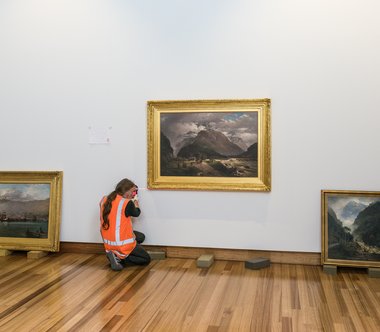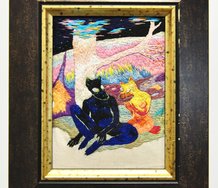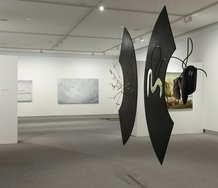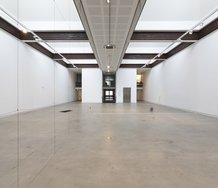Warren Feeney – 19 December, 2015
If the CAG's marketing has been characterised by a single element it has been its unassuming acceptance of the merit of truisms. It is not the first time in its recent history that the CAG has descended to platitudes. Indeed, it began with the slogan “good art matters,” in 2012, coined when its Outer Spaces programme was launched at Ng Building on Madras Street. What does “good art matters” mean? Absolutely nothing. Who would argue that good art does not matter?
For many good reasons, the staff at the Christchurch Art Gallery Te Puna o Waiwhetu are looking forward to re-opening after almost five years of closure. It represents a return to core business, working within a purpose-built gallery space and the end of frustrations that sometimes typified the temporary venues and sites of its Outer Spaces programme. The gallery can rightly claim that its reopening represents a milestone, a return to a kind of normality.
More importantly, prior to February 2011, Jenny Harper and gallery staff had achieved the most successful visual arts exhibition attendances in the city’s history. Between October 2010 and January 2011, 135,000 visitors had come to see Ron Mueck, a survey exhibition of hyper-realist sculpture by the Australian artist. Harper recently reflected that “with the Mueck exhibition closing early in 2011, we were confidently predicting several hundred thousand visitors would come to the gallery each year. Sixty-six per cent of those who attended that exhibition were from Christchurch and Canterbury, and 30,000 were first-time visitors.”
Yet, if this was not reason enough to believe that the Christchurch Art Gallery will be overwhelmed with visitors when it opens today - and it will be - the gallery’s marketing team has curiously made its marketing virtually an additional event, all of its own for the occasion. This does little for the public gallery’s credibility and gravitas.
If the CAG’s marketing has been characterised by a single element, it has been its unassuming acceptance of the merit of truisms. It is not the first time in its recent history that the CAG has descended to platitudes. Indeed, it began with the slogan “good art matters,” in 2012, coined when its Outer Spaces programme was launched at Ng Building on Madras Street. What does “good art matters” mean? Absolutely nothing. Who would argue that good art does not matter?
For the reopening, the CAG has conceived a catchphrase that it is equally impossible to disagree with. Yet this time around it seems worse, because of its life as a public persona accompanying the opening itself. “Art Makes Me…” invites every reader to fill in their own answer - and a number of these have been in newspapers, appeared as posters around the city, and on the gallery’s website. Others have been posted on the CAG’s Facebook page with a request to spread the good word on your own Facebook page.
So how have art enthusiasts responded? Art makes me…”wonder, think, whole, take notice, scared, laugh, squirm, curious, breathe, question, inspired, colourful, smile and happy.” In providing one-line responses the essential subtleties and complexities of the experience of the visual arts are kneecapped. Collectively, these truisms serve to confirm that whatever opinions there may be about the visual arts, all that they argue is that the arts are essentially a panacea.
Okay, you may be thinking; it’s a marketing strategy - not an artwork in the gallery’s collection. True, but it is also an attitude that has too readily found its way into the CAG’s public collection. Media releases for the request acquisition of Martin Creed’s EVERYTHING IS GOING TO BE ALRIGHT saw Harper state that the neon artwork was perfect for Christchurch: “It gives us reassurance and hope. For those of us that stayed in Christchurch, hope is what we have needed and clung to the most. It is remarkably simple and positive, reflecting our struggle over the past 5 years. It is perfect as a symbol. It is available for all to see and it is witty, humourous and egalitarian.”
Creed was in Christchurch for the launch of his work and also spoke affirmatively about its message. “The artwork was inspired by comforting words from a friend during a period of depression. I hope that in Christchurch people can make use of it. It is very important to say that it is just a little thing compared to people’s lives and the difficulty of life and the terrible, horrible shit that people go through in the world.”
There is a distinction between the two comments. Creed’s response is as much about the insubstantiality of such a message and an awareness that believing circumstances will improve is a necessary response to, and an awareness of, the tragedies of life. As Museum Associate Director Massimiliano Gioni, who curated a show of Creed in 2006 observed: “There’s a tragic element in [Creed’s] work. It’s about how you go on living by making choices or not.”
It remains surprising that the CAG has yet to publicly acknowledge the potential of Creed’s message. Certainly, being present outside the gallery when its lights were turned on, I noticed many residents walking past responding sceptically.
It is disingenuous to maintain that EVERYTHING IS GOING TO BE ALRIGHT is there to offer “reassurance and hope to all.” This limits the possibilities of Creed’s art, connecting the CAG with the general public through little more than another one of those obvious and meaningless truisms.
And Creed’s work is not alone. The other major acquisition of the CAG’s, Michael Parekowhai’s On First Looking into Chapman’s Homer, initially sited outside Ng building on Madras Street in July 2012, took on an unanticipated new life in the ruins of central Christchurch. “Over thirty days more than 50,000 people got out of their cars to see and photograph the two bulls on the edge of Christchurch’s red zone.” As a highly visible arts event that attracted many residents to return to the city, the CAG took the opportunity to redefine On First Looking into Chapman’s Homer as “a symbol of the extraordinary resilience of the people of Christchurch.” In itself this is an interesting association and one that cannot help but resurrect the symbolism, sentiment and iconography of social realist sculpture from the Soviet Union during the 1930s and 40s.
The symbolism of Parekowhai’s sculpture has since been fine-tuned by the CAG, acquiring a greater intimacy and familiarity, repeated on occasions when it has been relocated to various sites around the city. “If you’ve missed him as much as we have, come down and say hi, pat his nose or hoof, or snap him in a selfie. Chapman’s Homer will be at the Council offices for a few months.”
Which is fine. On First Looking into Chapman’s Homer can be whatever a community or an individual want it to be. However, what is worrying is that collectively “Art Makes Me…,” Creed’s EVERYTHING IS GOING TO BE ALRIGHT and Parekowahi’s On First Looking into Chapman’s Homer all suggest that the CAG’s marketing team has somehow assumed control of the Gallery as a newly conceived curatorial-marketing crew. The visual arts are poorly served by such a service, deprived of their very reason for being.
What should the visual arts be doing in a public art gallery? American artist Mike Kelley (1954-2012) comments on the purpose of art come to mind: “The only social function of art is to fuck things up. It has no other social function. Absolutely none. That’s why, if you merge it with the entertainment industry, make it about the desires of the masses, it doesn’t have any social function.”
Kelley puts it more bluntly than I would, and as a general statement all of its own, it deserves to be qualified. For example; the visual arts sometimes do community well-being really well. Yet, his observation captures an attitude that I trust the CAG will rediscover and embrace enthusiastically as it reopens. I look forward to an exhibition programme that is liberated - without any accompanying hyperbole - one that is ‘fucked-up’ enough not to be ‘on-brand.’
Warren Feeney


 Two Rooms presents a program of residencies and projects
Two Rooms presents a program of residencies and projects Advertising in this column
Advertising in this column



This Discussion has 0 comments.
Comment
Participate
Register to Participate.
Sign in
Sign in to an existing account.